2016 NISSAN TITAN maintenance
[x] Cancel search: maintenancePage 507 of 636
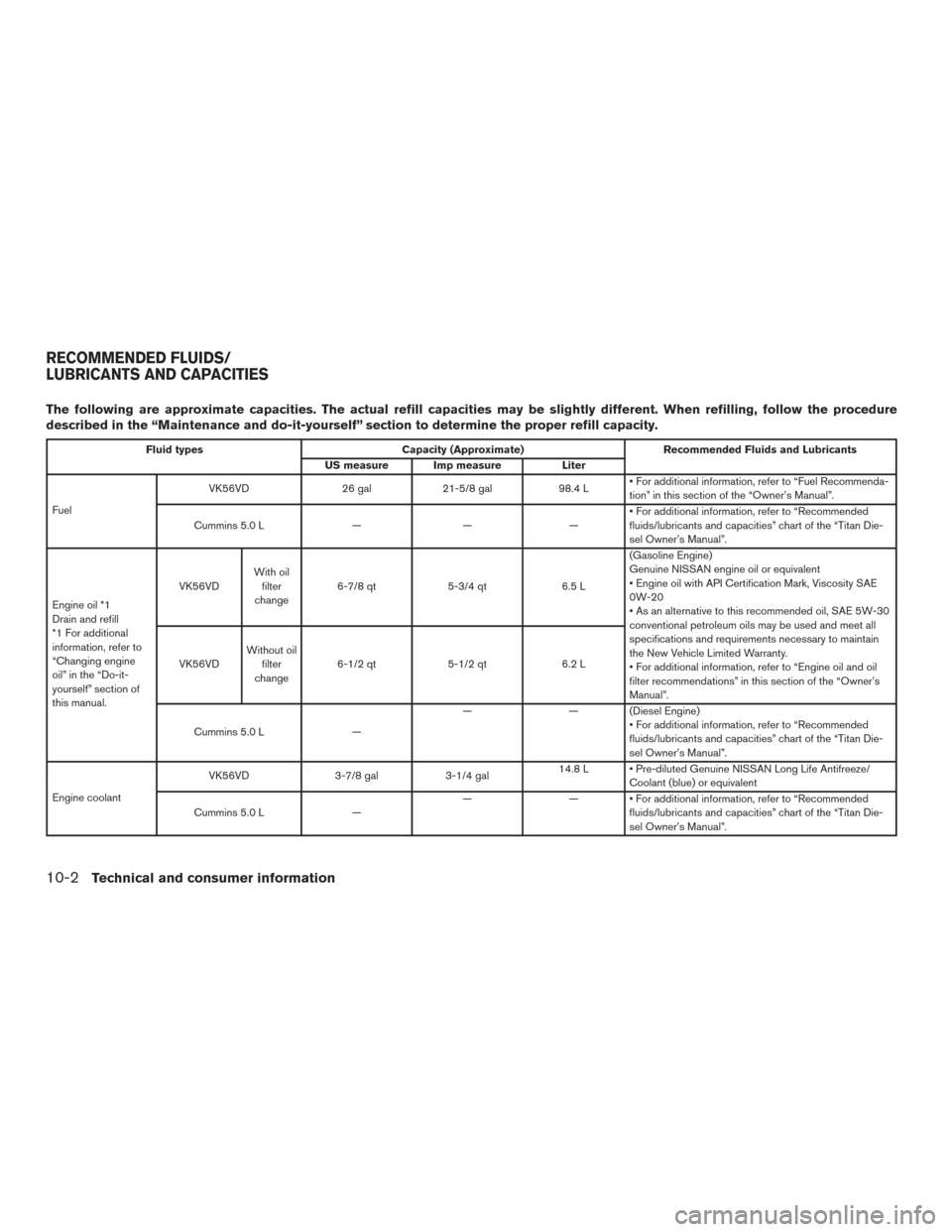
The following are approximate capacities. The actual refill capacities may be slightly different. When refilling, follow the procedure
described in the “Maintenance and do-it-yourself” section to determine the proper refill capacity.
Fluid typesCapacity (Approximate) Recommended Fluids and Lubricants
US measure Imp measure Liter
Fuel VK56VD
26 gal21-5/8 gal 98.4 L• For additional information, refer to “Fuel Recommenda-
tion” in this section of the “Owner’s Manual”.
Cummins 5.0 L ———• For additional information, refer to “Recommended
fluids/lubricants and capacities” chart of the “Titan Die-
sel Owner’s Manual”.
Engine oil *1
Drain and refill
*1 For additional
information, refer to
“Changing engine
oil” in the “Do-it-
yourself” section of
this manual. VK56VD
With oil
filter
change 6-7/8 qt
5-3/4 qt 6.5 L(Gasoline Engine)
Genuine NISSAN engine oil or equivalent
• Engine oil with API Certification Mark, Viscosity SAE
0W-20
• As an alternative to this recommended oil, SAE 5W-30
conventional petroleum oils may be used and meet all
specifications and requirements necessary to maintain
the New Vehicle Limited Warranty.
• For additional information, refer to “Engine oil and oil
filter recommendations” in this section of the “Owner’s
Manual”.
VK56VD
Without oil
filter
change 6-1/2 qt
5-1/2 qt 6.2 L
Cummins 5.0 L ——
— (Diesel Engine)
• For additional information, refer to “Recommended
fluids/lubricants and capacities” chart of the “Titan Die-
sel Owner’s Manual”.
Engine coolant VK56VD
3-7/8 gal3-1/4 gal 14.8 L • Pre-diluted Genuine NISSAN Long Life Antifreeze/
Coolant (blue) or equivalent
Cummins 5.0 L ——
— • For additional information, refer to “Recommended
fluids/lubricants and capacities” chart of the “Titan Die-
sel Owner’s Manual”.
RECOMMENDED FLUIDS/
LUBRICANTS AND CAPACITIES
10-2Technical and consumer information
Page 513 of 636
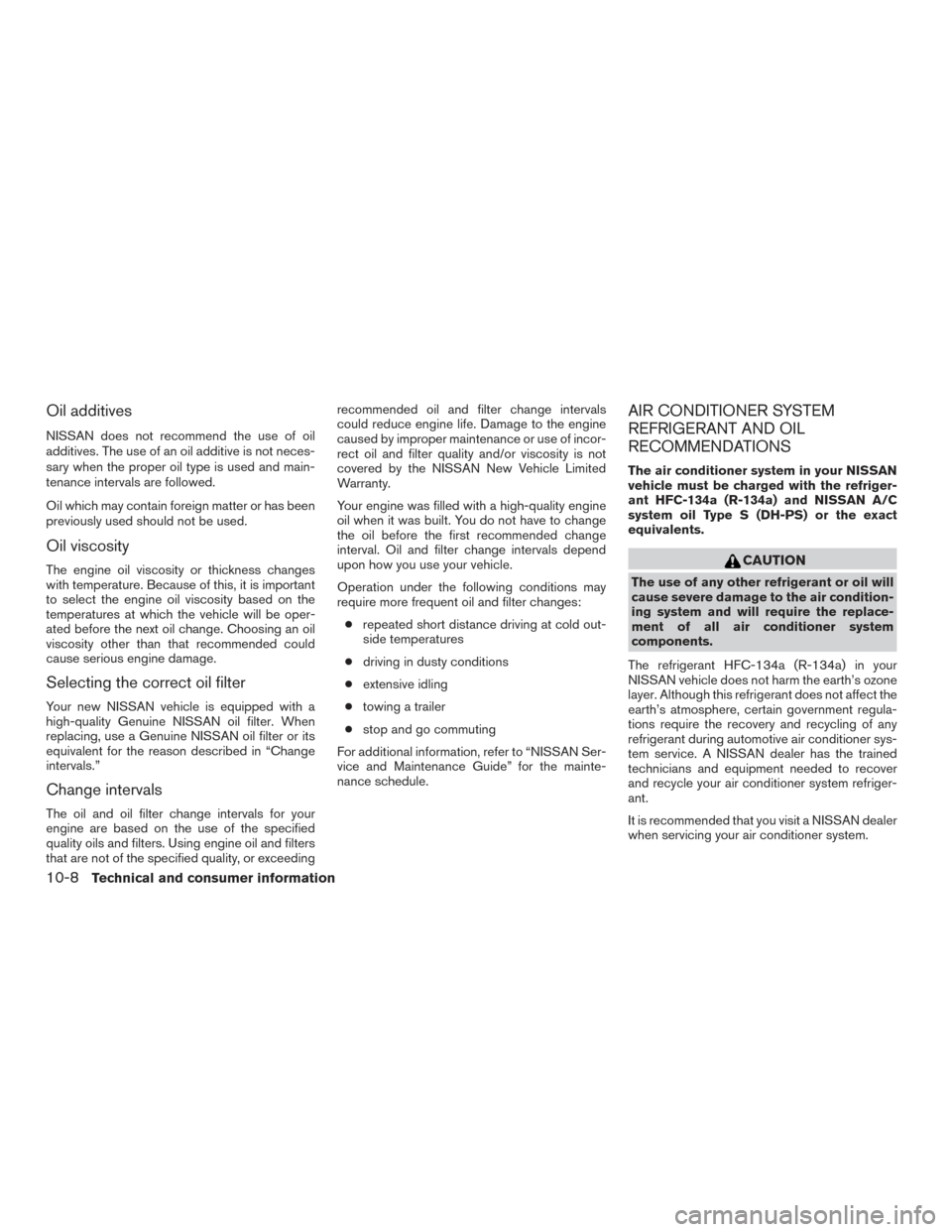
Oil additives
NISSAN does not recommend the use of oil
additives. The use of an oil additive is not neces-
sary when the proper oil type is used and main-
tenance intervals are followed.
Oil which may contain foreign matter or has been
previously used should not be used.
Oil viscosity
The engine oil viscosity or thickness changes
with temperature. Because of this, it is important
to select the engine oil viscosity based on the
temperatures at which the vehicle will be oper-
ated before the next oil change. Choosing an oil
viscosity other than that recommended could
cause serious engine damage.
Selecting the correct oil filter
Your new NISSAN vehicle is equipped with a
high-quality Genuine NISSAN oil filter. When
replacing, use a Genuine NISSAN oil filter or its
equivalent for the reason described in “Change
intervals.”
Change intervals
The oil and oil filter change intervals for your
engine are based on the use of the specified
quality oils and filters. Using engine oil and filters
that are not of the specified quality, or exceedingrecommended oil and filter change intervals
could reduce engine life. Damage to the engine
caused by improper maintenance or use of incor-
rect oil and filter quality and/or viscosity is not
covered by the NISSAN New Vehicle Limited
Warranty.
Your engine was filled with a high-quality engine
oil when it was built. You do not have to change
the oil before the first recommended change
interval. Oil and filter change intervals depend
upon how you use your vehicle.
Operation under the following conditions may
require more frequent oil and filter changes:
● repeated short distance driving at cold out-
side temperatures
● driving in dusty conditions
● extensive idling
● towing a trailer
● stop and go commuting
For additional information, refer to “NISSAN Ser-
vice and Maintenance Guide” for the mainte-
nance schedule.
AIR CONDITIONER SYSTEM
REFRIGERANT AND OIL
RECOMMENDATIONS
The air conditioner system in your NISSAN
vehicle must be charged with the refriger-
ant HFC-134a (R-134a) and NISSAN A/C
system oil Type S (DH-PS) or the exact
equivalents.
CAUTION
The use of any other refrigerant or oil will
cause severe damage to the air condition-
ing system and will require the replace-
ment of all air conditioner system
components.
The refrigerant HFC-134a (R-134a) in your
NISSAN vehicle does not harm the earth’s ozone
layer. Although this refrigerant does not affect the
earth’s atmosphere, certain government regula-
tions require the recovery and recycling of any
refrigerant during automotive air conditioner sys-
tem service. A NISSAN dealer has the trained
technicians and equipment needed to recover
and recycle your air conditioner system refriger-
ant.
It is recommended that you visit a NISSAN dealer
when servicing your air conditioner system.
10-8Technical and consumer information
Page 555 of 636
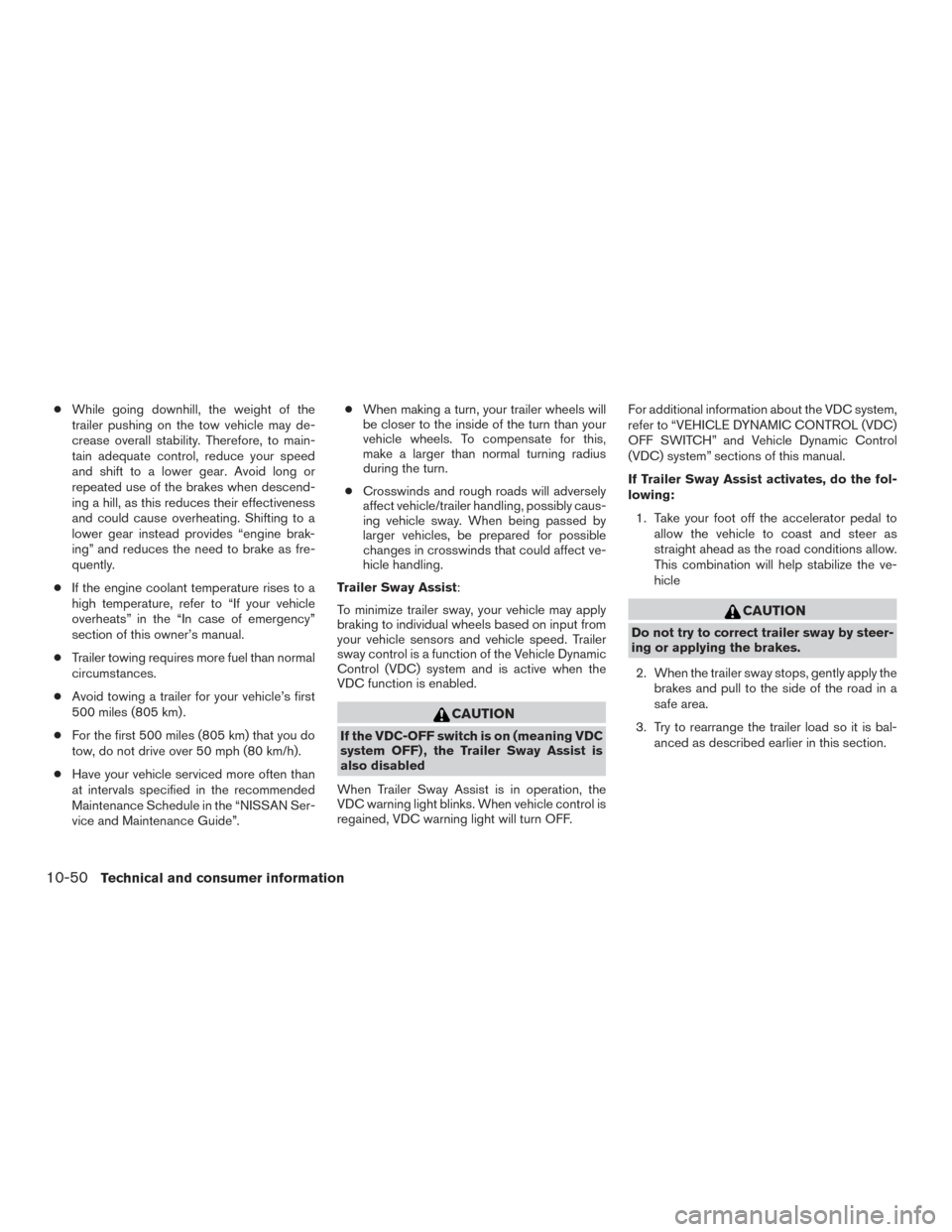
●While going downhill, the weight of the
trailer pushing on the tow vehicle may de-
crease overall stability. Therefore, to main-
tain adequate control, reduce your speed
and shift to a lower gear. Avoid long or
repeated use of the brakes when descend-
ing a hill, as this reduces their effectiveness
and could cause overheating. Shifting to a
lower gear instead provides “engine brak-
ing” and reduces the need to brake as fre-
quently.
● If the engine coolant temperature rises to a
high temperature, refer to “If your vehicle
overheats” in the “In case of emergency”
section of this owner’s manual.
● Trailer towing requires more fuel than normal
circumstances.
● Avoid towing a trailer for your vehicle’s first
500 miles (805 km) .
● For the first 500 miles (805 km) that you do
tow, do not drive over 50 mph (80 km/h).
● Have your vehicle serviced more often than
at intervals specified in the recommended
Maintenance Schedule in the “NISSAN Ser-
vice and Maintenance Guide”. ●
When making a turn, your trailer wheels will
be closer to the inside of the turn than your
vehicle wheels. To compensate for this,
make a larger than normal turning radius
during the turn.
● Crosswinds and rough roads will adversely
affect vehicle/trailer handling, possibly caus-
ing vehicle sway. When being passed by
larger vehicles, be prepared for possible
changes in crosswinds that could affect ve-
hicle handling.
Trailer Sway Assist:
To minimize trailer sway, your vehicle may apply
braking to individual wheels based on input from
your vehicle sensors and vehicle speed. Trailer
sway control is a function of the Vehicle Dynamic
Control (VDC) system and is active when the
VDC function is enabled.
CAUTION
If the VDC-OFF switch is on (meaning VDC
system OFF) , the Trailer Sway Assist is
also disabled
When Trailer Sway Assist is in operation, the
VDC warning light blinks. When vehicle control is
regained, VDC warning light will turn OFF. For additional information about the VDC system,
refer to “VEHICLE DYNAMIC CONTROL (VDC)
OFF SWITCH” and Vehicle Dynamic Control
(VDC) system” sections of this manual.
If Trailer Sway Assist activates, do the fol-
lowing:
1. Take your foot off the accelerator pedal to allow the vehicle to coast and steer as
straight ahead as the road conditions allow.
This combination will help stabilize the ve-
hicle
CAUTION
Do not try to correct trailer sway by steer-
ing or applying the brakes.
2. When the trailer sway stops, gently apply the brakes and pull to the side of the road in a
safe area.
3. Try to rearrange the trailer load so it is bal- anced as described earlier in this section.
10-50Technical and consumer information
Page 556 of 636
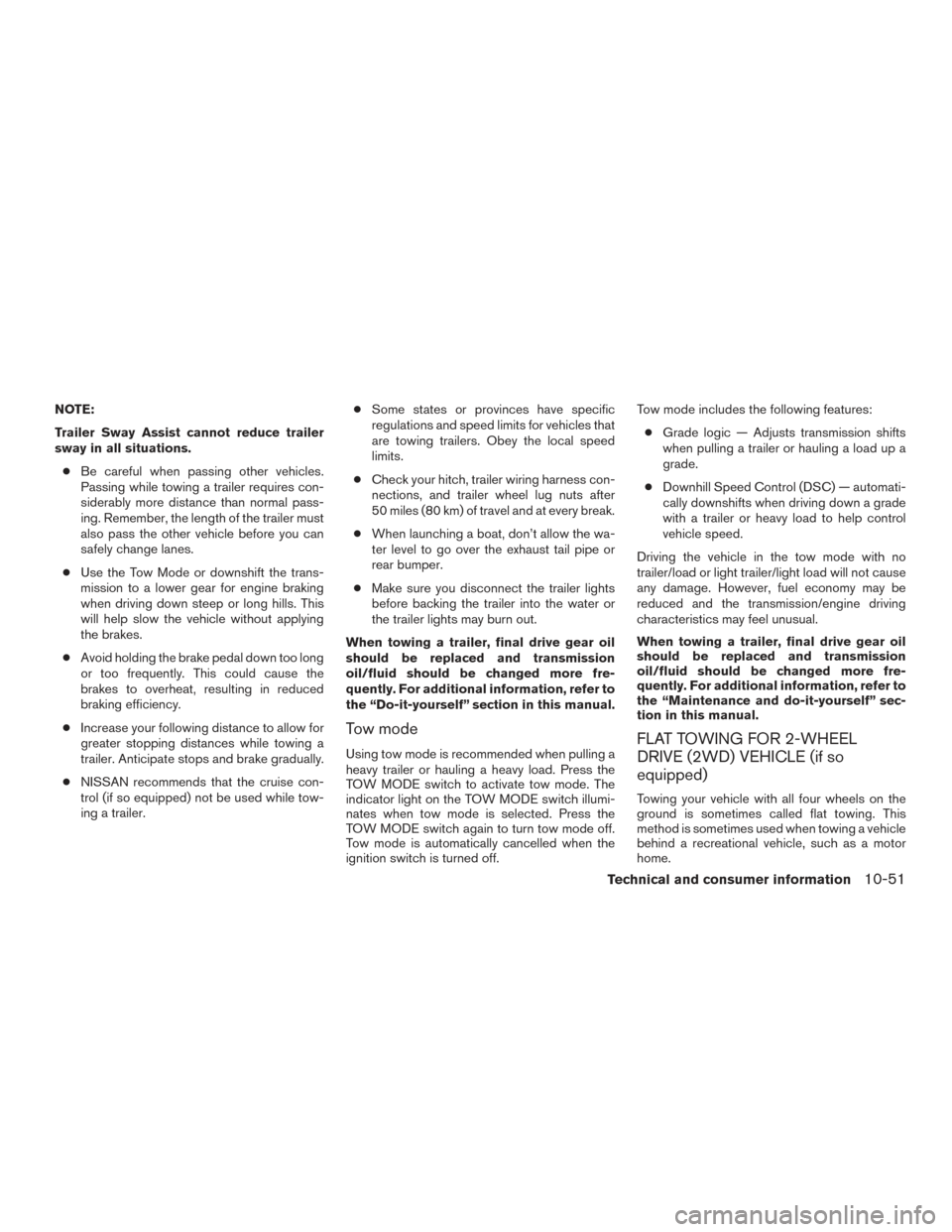
NOTE:
Trailer Sway Assist cannot reduce trailer
sway in all situations.● Be careful when passing other vehicles.
Passing while towing a trailer requires con-
siderably more distance than normal pass-
ing. Remember, the length of the trailer must
also pass the other vehicle before you can
safely change lanes.
● Use the Tow Mode or downshift the trans-
mission to a lower gear for engine braking
when driving down steep or long hills. This
will help slow the vehicle without applying
the brakes.
● Avoid holding the brake pedal down too long
or too frequently. This could cause the
brakes to overheat, resulting in reduced
braking efficiency.
● Increase your following distance to allow for
greater stopping distances while towing a
trailer. Anticipate stops and brake gradually.
● NISSAN recommends that the cruise con-
trol (if so equipped) not be used while tow-
ing a trailer. ●
Some states or provinces have specific
regulations and speed limits for vehicles that
are towing trailers. Obey the local speed
limits.
● Check your hitch, trailer wiring harness con-
nections, and trailer wheel lug nuts after
50 miles (80 km) of travel and at every break.
● When launching a boat, don’t allow the wa-
ter level to go over the exhaust tail pipe or
rear bumper.
● Make sure you disconnect the trailer lights
before backing the trailer into the water or
the trailer lights may burn out.
When towing a trailer, final drive gear oil
should be replaced and transmission
oil/fluid should be changed more fre-
quently. For additional information, refer to
the “Do-it-yourself” section in this manual.
Tow mode
Using tow mode is recommended when pulling a
heavy trailer or hauling a heavy load. Press the
TOW MODE switch to activate tow mode. The
indicator light on the TOW MODE switch illumi-
nates when tow mode is selected. Press the
TOW MODE switch again to turn tow mode off.
Tow mode is automatically cancelled when the
ignition switch is turned off. Tow mode includes the following features:
● Grade logic — Adjusts transmission shifts
when pulling a trailer or hauling a load up a
grade.
● Downhill Speed Control (DSC) — automati-
cally downshifts when driving down a grade
with a trailer or heavy load to help control
vehicle speed.
Driving the vehicle in the tow mode with no
trailer/load or light trailer/light load will not cause
any damage. However, fuel economy may be
reduced and the transmission/engine driving
characteristics may feel unusual.
When towing a trailer, final drive gear oil
should be replaced and transmission
oil/fluid should be changed more fre-
quently. For additional information, refer to
the “Maintenance and do-it-yourself” sec-
tion in this manual.FLAT TOWING FOR 2-WHEEL
DRIVE (2WD) VEHICLE (if so
equipped)
Towing your vehicle with all four wheels on the
ground is sometimes called flat towing. This
method is sometimes used when towing a vehicle
behind a recreational vehicle, such as a motor
home.
Technical and consumer information10-51
Page 560 of 636
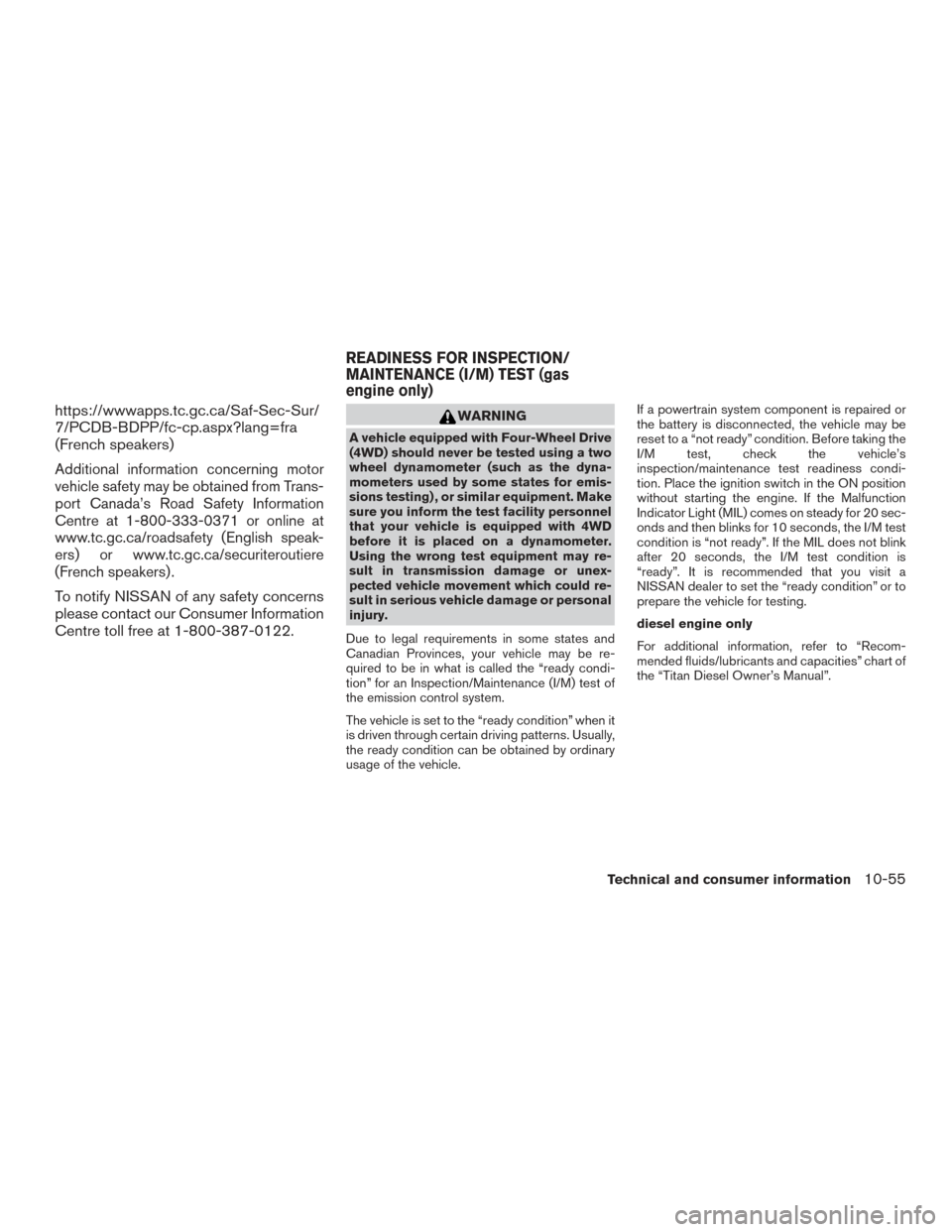
https://wwwapps.tc.gc.ca/Saf-Sec-Sur/
7/PCDB-BDPP/fc-cp.aspx?lang=fra
(French speakers)
Additional information concerning motor
vehicle safety may be obtained from Trans-
port Canada’s Road Safety Information
Centre at 1-800-333-0371 or online at
www.tc.gc.ca/roadsafety (English speak-
ers) or www.tc.gc.ca/securiteroutiere
(French speakers) .
To notify NISSAN of any safety concerns
please contact our Consumer Information
Centre toll free at 1-800-387-0122.
WARNING
A vehicle equipped with Four-Wheel Drive
(4WD) should never be tested using a two
wheel dynamometer (such as the dyna-
mometers used by some states for emis-
sions testing) , or similar equipment. Make
sure you inform the test facility personnel
that your vehicle is equipped with 4WD
before it is placed on a dynamometer.
Using the wrong test equipment may re-
sult in transmission damage or unex-
pected vehicle movement which could re-
sult in serious vehicle damage or personal
injury.
Due to legal requirements in some states and
Canadian Provinces, your vehicle may be re-
quired to be in what is called the “ready condi-
tion” for an Inspection/Maintenance (I/M) test of
the emission control system.
The vehicle is set to the “ready condition” when it
is driven through certain driving patterns. Usually,
the ready condition can be obtained by ordinary
usage of the vehicle. If a powertrain system component is repaired or
the battery is disconnected, the vehicle may be
reset to a “not ready” condition. Before taking the
I/M test, check the vehicle’s
inspection/maintenance test readiness condi-
tion. Place the ignition switch in the ON position
without starting the engine. If the Malfunction
Indicator Light (MIL) comes on steady for 20 sec-
onds and then blinks for 10 seconds, the I/M test
condition is “not ready”. If the MIL does not blink
after 20 seconds, the I/M test condition is
“ready”. It is recommended that you visit a
NISSAN dealer to set the “ready condition” or to
prepare the vehicle for testing.
diesel engine only
For additional information, refer to “Recom-
mended fluids/lubricants and capacities” chart of
the “Titan Diesel Owner’s Manual”.
READINESS FOR INSPECTION/
MAINTENANCE (I/M) TEST (gas
engine only)
Technical and consumer information10-55
Page 564 of 636
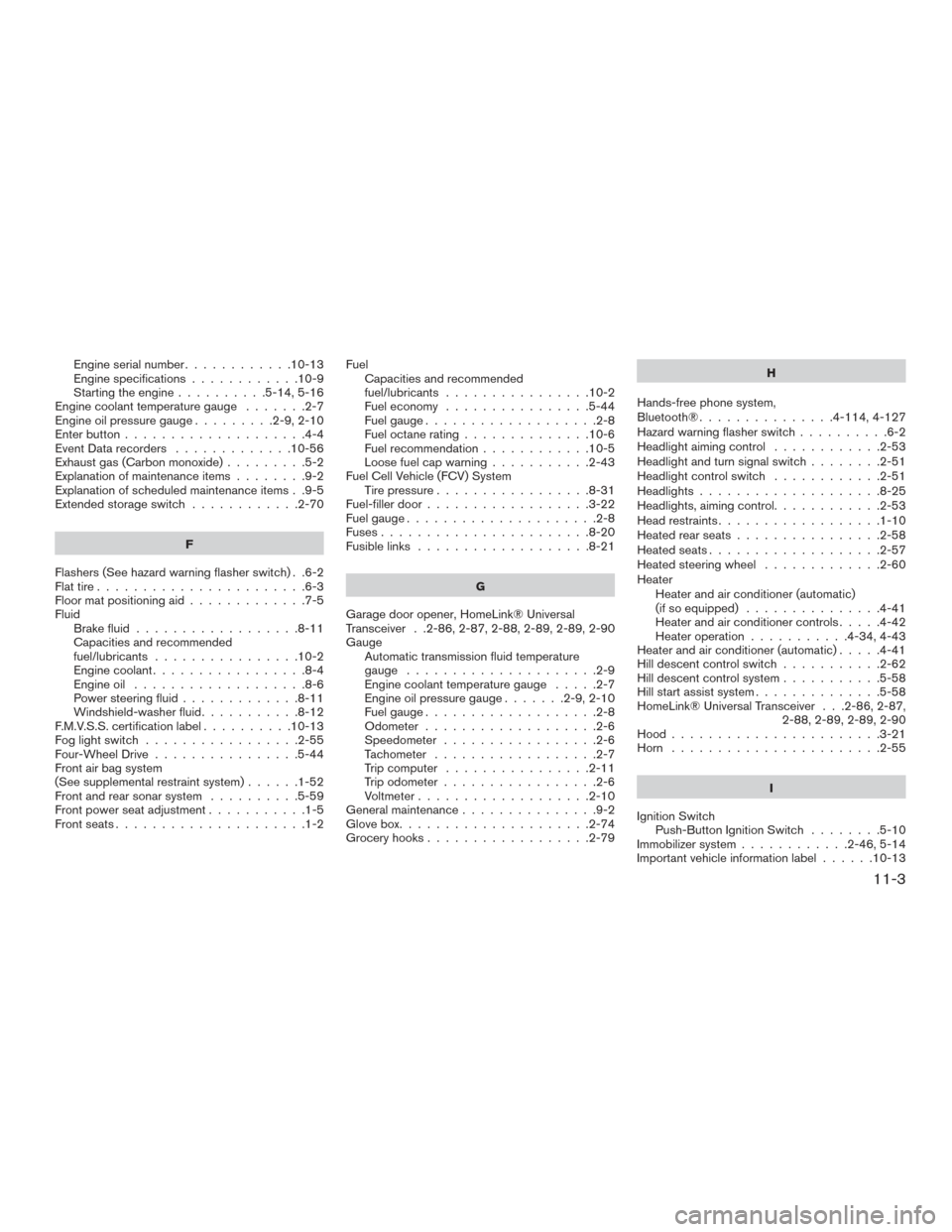
Engine serial number............10-13
Engine specifications ............10-9
Starting the engine ..........5-14,5-16
Engine coolant temperature gauge .......2-7
Engineoilpressuregauge.........2-9,2-10
Enterbutton....................4-4
Event Data recorders .............10-56
Exhaust gas (Carbon monoxide) .........5-2
Explanation of maintenance items ........9-2
Explanation of scheduled maintenance items . .9-5
Extendedstorageswitch ............2-70
F
Flashers (See hazard warning flasher switch) . .6-2
Flat tire .......................6-3
Floor mat positioning aid .............7-5
Fluid Brake fluid ..................8-11
Capacities and recommended
fuel/lubricants ................10-2
Engine coolant .................8-4
Engine oil ...................8-6
Power steering fluid .............8-11
Windshield-washerfluid...........8-12
F.M.V.S.S. certification label ..........10-13
Foglightswitch .................2-55
Four-Wheel Drive ................5-44
Front air bag system
(See supplemental restraint system) ......1-52
Front and rear sonar system ..........5-59
Front power seat adjustment ...........1-5
Frontseats.....................1-2 Fuel
Capacities and recommended
fuel/lubricants ................10-2
Fuel economy ................5-44
Fuel gauge ...................2-8
Fuel octane rating ..............10-6
Fuel recommendation ............10-5
Loose fuel cap warning ...........2-43
Fuel Cell Vehicle (FCV) System Tirepressure.................8-31
Fuel-filler door ..................3-22
Fuelgauge.....................2-8
Fuses.......................8-20
Fusiblelinks ...................8-21
G
Garage door opener, HomeLink® Universal
Transceiver . .2-86, 2-87, 2-88, 2-89, 2-89, 2-90
Gauge Automatic transmission fluid temperature
gauge .....................2-9
Engine coolant temperature gauge .....2-7
Engine oil pressure gauge .......2-9,2-10
Fuel gauge ...................2-8
Odometer ...................2-6
Speedometer .................2-6
Tachometer ..................2-7
Trip computer ................2-11
Trip odometer .................2-6
Voltmeter...................2-10
General maintenance ...............9-2
Glovebox.....................2-74
Grocery hooks ..................2-79 H
Hands-free phone system,
Bluetooth®...............4-114, 4-127
Hazard warning flasher switch ..........6-2
Headlightaimingcontrol ............2-53
Headlightandturnsignalswitch........2-51
Headlightcontrolswitch ............2-51
Headlights....................8-25
Headlights, aiming control ............2-53
Head restraints ..................1-10
Heated rear seats ................2-58
Heated seats ...................2-57
Heated steering wheel .............2-60
Heater Heater
and air conditioner (automatic)
(if so equipped) ...............4-41
Heater and air conditioner controls .....4-42
Heater operation ...........4-34,4-43
Heater and air conditioner (automatic) .....4-41
Hill descent control switch ...........2-62
Hill descent control system ...........5-58
Hill start assist system ..............5-58
HomeLink® Universal Transceiver . . .2-86, 2-87, 2-88, 2-89, 2-89, 2-90
Hood.......................3-21
Horn .......................2-55
I
Ignition Switch Push-Button Ignition Switch ........5-10
Immobilizer system ............2-46,5-14
Important vehicle information label ......10-13
11-3
Page 565 of 636

In-cabin microfilter................8-17
Increasing fuel economy .............5-44
Indicator lights and audible reminders
(See warning/indicator lights and audible
reminders).............2-19,2-20,2-26
Informationdisplay................2-29
Inside automatic anti-glare mirror ....3-27,3-28
Instrument brightness control ..........2-54
Instrument panel ...............0-6,2-2
Instrument panel dimmer switch ........2-54
Intelligent Key system Key operating range ..............3-9
Key operation ................3-10
Mechanicalkey ................3-4
Remote keyless entry operation.......3-13
Troubleshooting guide ............3-18
Warning signals ...............3-18
Interiorlight....................2-84
iPod®Player ...............4-73,4-75
ISOFIX child restraints .............1-28
J
Jump starting ...............6-10,8-14
K
Key.........................3-2
Key fob battery replacement ..........8-23
Keyless entry With Intelligent Key system
(See Intelligent Key system) .........3-13
Keys NISSAN Intelligent Key® ........3-2,3-8 NISSAN Vehicle Immobilizer System keys . .3-4
L
Labels Air conditioner specification label .....10-14
C.M.V.S.S. certification label .......10-13
Emission control information label ....10-14
Engine serial number ............10-13
F.M.V.S.S. certification label ........10-13
Tire and Loading Information label ....10-14
Vehicle identification number (VIN) ....10-12
Vehicle identification number (VIN)
plate.....................10-12
Warning labels (for SRS) ..........1-57
LATCH (Lower Anchors and Tethers for CHildren)
System ......................1-28
License plate Installing the license plate .........10-15
Light Air bag warning light .........1-58,2-26
Brake light (See stop light) .........8-28
Bulb check/instrument panel ........2-20
Bulbreplacement..............8-28
Charge warning light ............2-22
Consolelight.................2-85
Exterior and Interior lights ..........8-28
Foglights...................8-26
Foglightswitch ...............2-55
Headlight and turn signal switch ......2-51
Headlight control switch ..........2-51
Headlights..................8-25
Interiorlight..................2-84
Lightbulbs..................8-25
Low tire pressure warning light .......2-23Low windshield-washer fluid warning
light......................2-41
Personal lights
................2-86
Security indicator light ............2-28
Warning/indicator lights and audible
reminders ............2 -19, 2-20, 2-26
Lights.......................8-25 Maplights ..................2-85
Lock Child safety rear door lock ..........3-7
Door locks ...................3-5
Power door locks ............3-6,3-7
Loose fuel cap warning .............2-43
Low fuel warning light . . .2-23, 2-25, 2-39, 2-40
Low tire pressure warning light .........2-23
Low windshield-washer fluid warning light . . .2-41
Luggage
(See vehicle loading information) . .10-16
M
Maintenance General maintenance .............9-2
Insidethevehicle...............9-3
Maintenance precautions ...........8-2
Outside the vehicle ..............9-2
Seat belt maintenance ............1-23
Under the hood and vehicle .........9-4
Maintenancelog.................9-18
Maintenance requirements ............9-2
Malfunction indicator light ........2-25,2-27
Manual front seat adjustment ...........1-4
Maplights ....................2-85
Mappocket....................2-71
Memory Seat ...................3-36
Meters and gauges .............2-4,2-9
11-4
Page 566 of 636
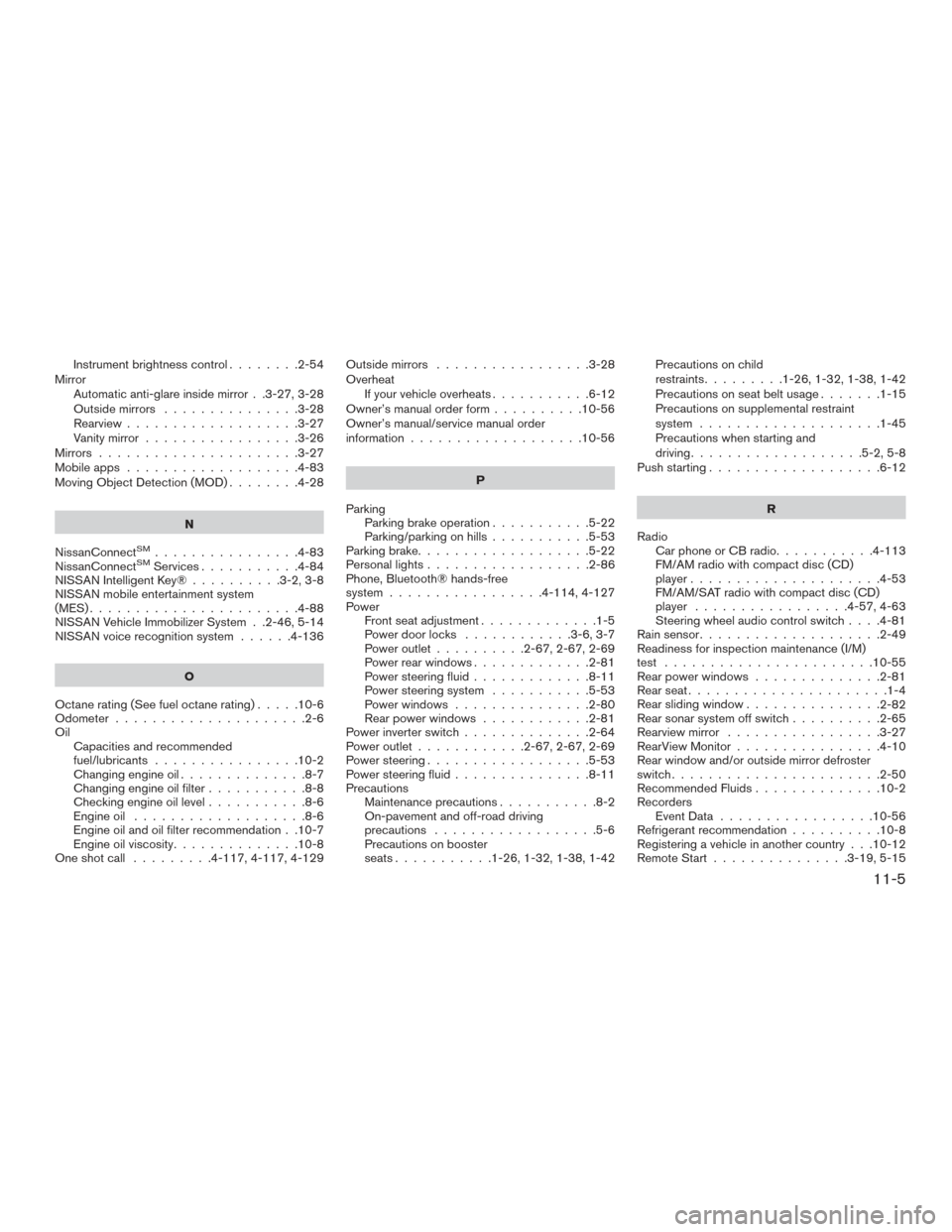
Instrument brightness control........2-54
Mirror Automatic anti-glare inside mirror . .3-27, 3-28
Outside mirrors ...............3-28
Rearview ...................3-27
Vanity mirror .................3-26
Mirrors ......................3-27
Mobileapps ...................4-83
Moving Object Detection (MOD) ........4-28
N
NissanConnect
SM................4-83
NissanConnectSMServices...........4-84
NISSAN Intelligent Key® ..........3-2,3-8
NISSAN mobile entertainment system
(MES) .......................4-88
NISSAN Vehicle Immobilizer System . .2-46, 5-14
NISSAN voice recognition system ......4-136
O
Octanerating(Seefueloctanerating).....10-6
Odometer .....................2-6
Oil Capacities and recommended
fuel/lubricants ................10-2
Changing engine oil ..............8-7
Changing engine oil filter ...........8-8
Checking engine oil level ...........8-6
Engine oil ...................8-6
Engine oil and oil filter recommendation . .10-7
Engine oil viscosity ..............10-8
Oneshotcall .........4- 117, 4-117, 4-129Outside mirrors
.................3-28
Overheat If your vehicle overheats ...........6-12
Owner’s manual order form ..........10-56
Owner’s manual/service manual order
information ...................10-56
P
Parking Parking brake operation ...........5-22
Parking/parking on hills ...........5-53
Parking brake ...................5-22
Personallights..................2-86
Phone, Bluetooth® hands-free
system .................4- 114, 4-127
Power Front seat adjustment .............1-5
Power door locks ............3-6,3-7
Power outlet ..........2-67,2-67,2-69
Power rear windows .............2-81
Power steering fluid .............8-11
Power steering system ...........5-53
Power windows ...............2-80
Rear power windows ............2-81
Power inverter switch ..............2-64
Power outlet ............2-67,2-67,2-69
Power steering ..................5-53
Power steering fluid ...............8-11
Precautions Maintenance precautions ...........8-2
On-pavement and off-road driving
precautions ..................5-6
Precautions on booster
seats...........1-26,1-32,1-38,1-42 Precautions on child
restraints
.........1-26,1-32,1-38,1-42
Precautions on seat belt usage .......1-15
Precautions on supplemental restraint
system ....................1-45
Precautions when starting and
driving ...................5-2,5-8
Push starting ...................6-12
R
Radio CarphoneorCBradio...........4-113
FM/AM radio with compact disc (CD)
player .....................4-53
FM/AM/SAT radio with compact disc (CD)
player .................4-57,4-63
Steering wheel audio control switch . . . .4-81
Rainsensor....................2-49
Readiness for inspection maintenance (I/M)
test .......................10-55
Rear power windows ..............2-81
Rearseat......................1-4
Rear sliding window ...............
2-82
Rear sonar system off switch ..........2-65
Rearview mirror .................3-27
RearView Monitor ................4-10
Rear window and/or outside mirror defroster
switch.......................2-50
Recommended Fluids ..............10-2
Recorders EventData .................10-56
Refrigerant recommendation ..........10-8
Registering a vehicle in another country . . .10-12
Remote Start ...............3-19,5-15
11-5